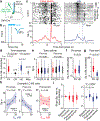Spatiotemporal dynamics of noradrenaline during learned behaviour
- PMID: 35650441
- PMCID: PMC9837982
- DOI: 10.1038/s41586-022-04782-2
Spatiotemporal dynamics of noradrenaline during learned behaviour
Abstract
Noradrenaline released from the locus coeruleus (LC) is a ubiquitous neuromodulator1-4 that has been linked to multiple functions including arousal5-8, action and sensory gain9-11, and learning12-16. Whether and how activation of noradrenaline-expressing neurons in the LC (LC-NA) facilitates different components of specific behaviours is unknown. Here we show that LC-NA activity displays distinct spatiotemporal dynamics to enable two functions during learned behaviour: facilitating task execution and encoding reinforcement to improve performance accuracy. To examine these functions, we used a behavioural task in mice with graded auditory stimulus detection and task performance. Optogenetic inactivation of the LC demonstrated that LC-NA activity was causal for both task execution and optimization. Targeted recordings of LC-NA neurons using photo-tagging, two-photon micro-endoscopy and two-photon output monitoring showed that transient LC-NA activation preceded behavioural execution and followed reinforcement. These two components of phasic activity were heterogeneously represented in LC-NA cortical outputs, such that the behavioural response signal was higher in the motor cortex and facilitated task execution, whereas the negative reinforcement signal was widely distributed among cortical regions and improved response sensitivity on the subsequent trial. Modular targeting of LC outputs thus enables diverse functions, whereby some noradrenaline signals are segregated among targets, whereas others are broadly distributed.
© 2022. The Author(s), under exclusive licence to Springer Nature Limited.
Conflict of interest statement
Figures















References
Methods references
MeSH terms
Substances
Grants and funding
LinkOut - more resources
Full Text Sources
Molecular Biology Databases
Research Materials

